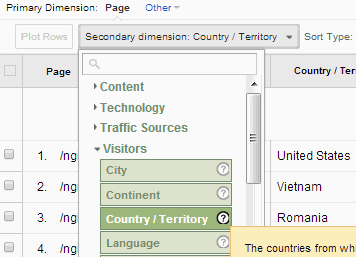Making The Most Of SEO with Secondary Dimension in Google Analytics
Wiki Article
Unlock Deeper Insights With Second Dimension in Google Analytics
With the substantial expanse of data available in Google Analytics, the usage of second dimensions can significantly enhance your logical abilities. By strategically incorporating second measurements into your evaluation, you can uncover valuable understandings that may otherwise continue to be obscure - Secondary Dimension in Google Analytics.Comprehending Key Vs. Additional Dimensions
When assessing data in Google Analytics, it is vital to compare secondary and primary measurements to acquire much deeper insights into customer actions. Primary dimensions are the major categories whereby you can see your information, such as tool, source/medium, or landing page. These measurements supply the fundamental structure for arranging and comprehending your information. On the other hand, secondary dimensions enable you to additional dissect your main dimension data. By including a secondary dimension, you can layer on additional info to your key measurement, allowing a more granular analysis. If your main dimension is the source/medium with which users arrived on your site, adding a secondary measurement like geographic location can disclose where those customers are located geographically. When looking at the main measurement alone, this added layer of information can aid you recognize fads, patterns, or abnormalities that may not have actually been noticeable. For that reason, leveraging both second and main measurements in Google Analytics is critical for thorough data evaluation and educated decision-making.Utilizing Additional Measurements Properly
Efficiently using second dimensions in Google Analytics enhances the depth and granularity of information analysis, supplying valuable insights into individual habits and fads. By including additional measurements together with main measurements, analysts and marketing professionals can delve much deeper right into the specifics of customer interactions on their internet sites. Second dimensions allow users to section and filter main measurement data better, using an extra thorough sight of individual communications, demographics, and habits. This can be specifically valuable when attempting to understand the influence of details variables on user interaction, such as the web browsers or gadgets they are utilizing, the resources of their traffic, or their geographic areas.In addition, additional dimensions enable customers to contrast and contrast various data factors within a single report, facilitating a much more detailed analysis of customer habits patterns. By leveraging secondary dimensions efficiently, businesses can reveal concealed insights, maximize their marketing methods, and boost the general customer experience on their web sites.
Discovering Usual Additional Measurement Combinations
To additionally evaluate customer habits and fads in Google Analytics, it is useful to check out common combinations of secondary measurements. Some common additional dimension mixes that provide useful understandings include analyzing website traffic sources with customer locations to comprehend where site site visitors are coming from geographically and just how they found the website. Checking out user habits metrics with secondary measurements such as demographics or interests can aid in targeting particular target market sections a lot more efficiently.Applying Secondary Measurement in Custom Information
Utilizing additional measurements in personalized reports enables an extra comprehensive evaluation of information in Google Analytics, boosting the deepness of insights obtained. When creating custom-made records in Google Analytics, including second measurements can offer a much more thorough sight of just how various dimensions communicate with each other. This function allows individuals to delve deeper into their data and discover useful relationships that might not be immediately apparent.By using secondary dimensions in custom reports, users can obtain a better understanding of their website or application website traffic. Combining the primary dimension of "source/medium" with the second measurement of "landing page" can expose which landing pages are doing finest for traffic coming from details resources. This insight can aid marketing experts maximize their campaigns and improve total conversion prices.

Enhancing Data Visualization With Second Dimension
When discovering data in Google Analytics personalized reports, integrating secondary measurements not only gives a more thorough evaluation but likewise enhances the graph of insights with information visualization. By including a second measurement to your records, you can improve the method information exists, making it simpler to recognize patterns, fads, and correlations within your site's efficiency metrics.Additional dimensions can assist you check this sector your information better, permitting a deeper understanding of user behavior and communications on your site. When trying to separate details variables that may affect your internet site's efficiency., this enhanced degree of granularity can be specifically useful.

Final Thought
In verdict, leveraging secondary measurements in Google Analytics enables a much more thorough analysis of data, bring about much deeper insights and even more informed decision-making. Secondary Dimension in Google Analytics. By adding added layers of details to main information sets, experts and marketers can reveal concealed trends, patterns, and connections that provide a granular sight of user behavior and interactions. This enhanced level of understanding allows optimization of projects and tailored approaches for particular target market sections, ultimately boosting efficiency and conversion ratesOn the various other hand, secondary dimensions allow you to additional explore your key dimension information. By including an additional dimension, you can layer on additional info to your main measurement, enabling a much more granular analysis. If try this site your key dimension is the source/medium via which users arrived on your site, including a secondary dimension like geographical area can reveal where those users are situated geographically. By including additional measurements along with key dimensions, online marketers and analysts can dig deeper into the specifics of individual communications on their websites. Secondary dimensions permit users to segment and filter primary measurement information this website better, offering a more in-depth sight of customer demographics, interactions, and behaviors.
Report this wiki page